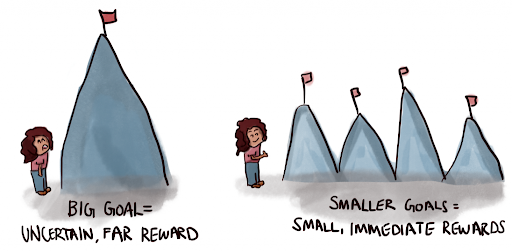Even great software doesn’t sell itself. Are you too facing the following problems for your SaaS business:
- You are struggling to attract visitors.
- You attract visitors but do not generate qualified leads.
- You struggle to convert your leads into customers.
- Your churn rate is holding back your growth.
If you can relate to any of these, it is time to change your SAAS marketing strategy. This blog will be your guide in the process.
What is SAAS Marketing?
To understand the concept of SaaS marketing, first, you need to take a look at the definition of SaaS: offering Software as a Service. With SaaS, consumers get access to softwares from cloud storage that solves particular problems for businesses and organizations. They pay for such softwares on a subscription basis.

SaaS marketing is the process to promote the SAAS softwares. The goal is to build product awareness and enhance the brand’s reach. In other words, it is the process of adapting marketing strategies to promote and sell cloud softwares. Although different product niches may have different promotion approaches, the goal remains the same.
Planning SAAS Marketing – Define Your Marketing Objectives
Of course, the main objective is to sell your software. But to reach there, you need to take baby steps with proper planning. First, divide your main goal into small goals as per your buyer’s journey in your marketing funnel. For example, you can set these goals:
- Goal 1 Get the clients to create an account.
- Goal 2 Make the clients activate the trial version.
- Goal 3 Get clients to request a demo presentation.
- Goal 4 Make clients subscribe to email distribution.
Align your SaaS marketing approach with each of these goals. Your strategy should work on achieving these milestones simultaneously or one by one. The SaaS marketing content, tools and channels will vary depending on the objective you are working on.
When moving from one objective to another, you will learn the effectiveness of the various channels and tools. This information will help you to create a new marketing plan in the future, considering the previous methods and their results.
Determine the Marketing Budget
As per SaaScribe’s analysis of public SaaS companies, $1 spent on marketing-generated $2.20 in sales over two years. This suggests that the investment in marketing is a positive long-term investment.
When it comes to the financial component in creating a marketing plan, different SAAS companies have different opinions. According to data analysis, some SaaS companies invest 80-120% of their revenue in marketing, while others use 40% of their revenue for the same. Therefore, you need to brainstorm and figure out what works best for you.
SaaS Marketing Strategy – Focus on Target Audience and Channels
For a SaaS business to grow, it needs a well-planned marketing strategy. As with any niche, there are many strategy models in SaaS. But each model requires to pay attention to:
Target Audience
Your SaaS marketing strategy should be customer-centric. Therefore, you should plan your strategy as per your audience’s needs, behaviors, interests, and concerns in mind.
Define your audience with market research to develop buyers’ persona. The more precisely you do this, the more are the chances of the success of your strategy.

These points will guide you in this purpose:
Your Prospects’ Problem That Your Product Will Solve
Your SaaS software offers a solution to your prospect’s problem. First, you need to search for the audience that has that problem.
The Buying Decision Process of Your Target Audience
Different factors can influence their purchase decision. So choose your pricing as per your audience’s budgets and your competitors’ prices.
Identify the Main Features of Your SaaS Software
Discover the relationship between your buyers and the specific characteristics of your product. Different buyers will have different requirements and preferences. For example, a buyer might prefer big storage space. But, at the same time, another buyer may have a different interest.
Know Their Obstacles in Their Purchasing Decision
Research – What can be the potential points of objection for your potential buyers? It may be a high price or lack of specific features/technology etc. If you can find a solution to these potential roadblocks, you’ll be more likely to succeed.
Develop SAAS Marketing Strategy to Achieve Chosen Objectives
Once you are done with the objectives, budget, and target audience, it is now time to choose the strategies. At this point, the marketer’s job is to develop unique and effective tactics that outperform competitors’ tactics.
With the availability of all the digital marketing tactics today, this can be a huge topic. However, as per experts, the best bet is to count on two basic SaaS marketing tactics:
Content Marketing For SaaS

Content marketing can help to grow a business in any niche. The main task of this approach is to increase traffic on the blog pages. However, succeeding with content marketing in SaaS is not a piece of cake for businesses and professionals.
It takes a long time to see content marketing results in the SaaS space. Also, the traffic you get on your website using content marketing may not generate qualified leads.
To drive leads from SAAS content marketing, you need a detailed content strategy. Often SaaS businesses do not give sufficient time and effort to develop a content strategy. Thus their content marketing strategy bears no fruit.
You can create a successful content marketing strategy at the lowest financial cost with brainstorming. Here are the detailed steps to create a content marketing strategy for SaaS:
- Competitor analysis: Analyze competitor’s content using tools like Ahref.
- Learn what types of articles they write. Which types of articles gather the most traffic.
- Next, analyze which keywords have impressions. You can use Ahrefs or Google Ads Keywords Tools.
- Aim for keywords with visible search volume but manageable competition.
- Choose topics on the real needs and problems of your target customers.
- Successful SaaS content marketing involves understanding your buyer persona and then creating content.
- The better your audience understands and engages with your content to reach the better you can convert them into valuable leads.
- With this data, create an SEO optimized blog. It will attract qualified leads.
- Provide article structure and keywords to your SaaS SEO writers.
- Check the article for quality, errors and SEO.
- Add images and relevant examples in the articles.
- Keep an eye on their indexing in Google.
- Once indexed, promote them on social networks.
- Schedule an email newsletter.
- Check if impressions are increasing in Google Search Console. If not, there is something wrong with the content, and you need to reanalyze your content.
Remember, there are two ways to approach any content:
Way 1 You can develop comprehensive, detailed, in-depth, informative content on a specific topic.
Way 2 You can develop an article covering a mix of sub-topics around the main topic.
For example, when writing on SaaS marketing, you can either write a comprehensive guide on SaaS content marketing or can mention different SaaS marketing strategies as we did in this blog.
Also, content today comes in different forms – blog posts, articles, infographics, videos and podcasts. Use multiple forms of content as per your audiences. For example, Hubspot advises covering a trending and ranking topic in different forms. It helps to attract more leads.
Pro Tip:
When it comes to SaaS content marketing or for any other niche, there is one key factor to focus on:
There are three different stages in a buyer’s journey: lead generation, lead nurturing, and customer acquisition. Although you should develop content for each of these stages, you should focus on one or two of them to highlight your strengths.
Nevertheless, creating good content is crucial, but it is of no use if it fails to attract leads. Promoting the content is as important as creating the content itself. And the most effective way to promote content is by implementing SEO.
Paid Advertisements And Promotions
Despite the fact that content and SEO marketing are very fruitful for SaaS companies, they have a downside. It is – they are long-term. They require at least six to twelve months or more, to show worthy results.

That’s where paid marketing enters the picture. It fills the void of waiting a long duration to see notable outcomes. Paid advertising guarantees fast results.
There are plenty of options in paid advertising. But we suggest you focus on there these three channels:
Paid Promotion of Content
There are different channels you can use to promote your content. The goal here is to enhance your content’s reach so it reaches more people in less time. These are the most important channels for this purpose:
- Google Ads
- Facebook Ads
- Linkedin Ads (for B2B SaaS companies)
- Guest Posting to support your SEO
Paying Influencers For Promoting
Influencer marketing is very effective for the SaaS niche. A well-known influencer can promote your SaaS product or your content.
The main thing here is to get the right fit. That is an influencer who is a famous personality in your niche. There are many outreach tools that you can use.
Note: You can work with micro-influencers as per your niche initially to see how it works and what will be the results.
Retargeting Ads
Running retargeting ads is displaying an advertisement to those who have earlier engaged with your content on your website, social media or other channels.
Google Ads also allows you to target users who have previously performed certain actions that relate to your product such as visiting other sites like yours (including your competitors) or searching for relative specific SaaS queries.
You can run retargeting campaigns on Google, LinkedIn and Facebook. Moreover, there are also platforms like Sharp Spring that can run your promotions across multiple platforms simultaneously.
Key Points To Note When Planning SaaS Paid Advertising:
- Remember that these paid promotional efforts should amplify your content marketing.
- Paid advertising can be very expensive and thus require a big budget.
- Paid promotional channels and content marketing must work together to maintain profitability while reducing the time it takes to see results.
- But the budget is not the only crucial thing here. You also need to have a proper understanding of paid advertising. You should know:
Which channels to bet on?
Which keyphrases to run your ads for?
What should be the maximum amount to spend in a day?
How to keep track of conversions?
To get maximum profitability, you should plan to hire an agency having ample experience in SaaS paid advertising.
Gather Resources For Your SaaS Marketing Strategy
Doing planning without any execution is merely nothing. So, now as you’ve chosen the strategy objectives, it’s time to consider the resources you will need to execute the strategy. The number one is the budget which we have already discussed above.
Then comes the most critical consideration – who will handle, execute and manage your SaaS marketing strategy. There are three options to choose from:
- An in-house team
- Hiring a SaaS Seo agency
- Work with a freelancer – a SaaS marketing consultant.
Plan your resources needs list wisely looking at all the possibilities. You can also choose a combination of options from the list. Other than that, you may have to invest in other assets like some digital marketing tools.
Create a Marketing Evaluation Process
When executing SaaS marketing, it is important to measure and evaluate the results of your marketing strategy. This process involves tracking revenue and changes to set marketing goals.

Steps For Evaluation Process:
- Use monthly reporting to ensure follow-up of actions and results of collaborative work between marketing and sales teams
- Use a lead scoring system to identify prospects automatically
- Connected marketing software and CRM to facilitate the passage of leads between teams
- Create a common monthly reporting to measure collaborative work efforts
- Analyze your performance and your competitor’s performance. Make adjustments in your tactics accordingly.
For that, you need to have the correct metrics and KPIs.
Must have metrics in your strategy are:
Churn Rate: How many customers you lose in a certain time duration. For example, if 10 of your total 100 customers cancel their plans in a month X, your churn rate for that X month will be 10% as per the formulae 10/100 x 100.
Customer Acquisition Price / Cost: How much money you spend to gain one customer.
MRR (Monthly Recurring Revenue): It is the estimate of your monthly revenue collection stream. The calculation of MRR depends on the pricing model and other factors.
Loss in Revenue: The loss in revenue because of the churn rate at any specific time.
MQL Velocity Rate: It stands for Marketing Qualified Lead Velocity Rate. It is the calculation of the increase in your qualified leads on a monthly basis.
There are also other metrics that you can use to track the performance of your marketing SaaS.
Finally – Why is SaaS on The Rise?
Customers love this model for its simplicity. It is efficient and requires no installation. With SaaS, hardware failures and operational errors, which are commonplace on machines, do not result in significant data loss.
SaaS companies achieve uptime rates (percentage of time software is accessible and working properly,) far beyond what most IT teams can claim.
Furthermore, SaaS software is more affordable than its traditional counterparts. This is a determining factor for users who do not yet know which software to adopt in the long term or, on the contrary, need software for a short period.
SaaS software is also popular with developers who particularly appreciate the SaaS distribution model. Most SaaS software runs on servers. Therefore, the majority of B2C and B2B SaaS software can be accessed over the Internet from servers by the vendors. So, whenever a technical issue arises (which is rare), vendors can troubleshoot it online in very little time.
Moreover, SaaS is popular with companies and investors for its business model, which is much more attractive than the sale of software licenses. Revenues generated by SaaS are generally recurring. This makes the cash flows of SaaS companies particularly predictable.
It allows them to plan accordingly and monetize their future cash flows to fund their current growth. SaaS companies are thus showing some of the highest growth rates in the history of the software sector.
To Wrap Up
SaaS marketing may be unique from other industries. However, with proper planning, research and brainstorming, you can create an effective SaaS marketing strategy for your business.
If you follow the above-given steps, you will surely create a fruitful SaaS marketing approach. However, note that the data will change as you execute the strategy. For example, in the middle of the plan, your business might have multiple target audiences and thus require different marketing channels.
If you need a B2B SaaS marketing consultant, schedule a call with us![/vc_column_text][/vc_column][/vc_row]
